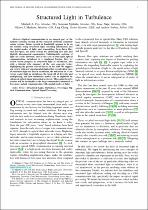JavaScript is disabled for your browser. Some features of this site may not work without it.
- ResearchSpace
- →
- Research Publications/Outputs
- →
- Journal Articles
- →
- View Item
| dc.contributor.author |
Cox, MA

|
|
| dc.contributor.author |
Mphuthi, N

|
|
| dc.contributor.author |
Nape, I

|
|
| dc.contributor.author |
Mashaba, Nikiwe P

|
|
| dc.contributor.author |
Cheng, L

|
|
| dc.contributor.author |
Forbes, A

|
|
| dc.date.accessioned | 2021-01-04T11:29:46Z | |
| dc.date.available | 2021-01-04T11:29:46Z | |
| dc.date.issued | 2020-09 | |
| dc.identifier.citation | Cox, M.A. (et.al.) 2020. Structured light in turbulence. IEEE Journal of Selected Topics in Quantum Electronics, v27(2), 22pp. | en_US |
| dc.identifier.issn | 1077-260X | |
| dc.identifier.issn | 1558-4542 | |
| dc.identifier.uri | https://ieeexplore.ieee.org/document/9198098 | |
| dc.identifier.uri | ttps://ieeexplore.ieee.org/document/9198098/authors#authors | |
| dc.identifier.uri | http://hdl.handle.net/10204/11700 | |
| dc.description | Copyright: 2020 IEEE. This is the preprint version of the work. For access to the published item, please visit the publisher's website. | en_US |
| dc.description.abstract | Optical communication is an integral part of the modern economy, having all but replaced electronic communication systems. Future growth in bandwidth appears to be on the horizon using structured light, encoding information into the spatial modes of light, and transmitting them down fibre and free-space, the latter crucial for addressing last mile and digitally disconnected communities. Unfortunately, patterns of light are easily distorted, and in the case of free-space optical communication, turbulence is a significant barrier. Here we review recent progress in structured light in turbulence, first with a tutorial style summary of the core concepts, before highlighting the present state-of-the-art in the field. We support our review with new experimental studies that reveal which types of structured light are best in turbulence, the behaviour of vector versus scalar light in turbulence, the trade-off of diversity and multiplexing, and how turbulence models can be exploited for enhanced optical signal processing protocols. This comprehensive treatise will be invaluable to the large communities interested in free-space optical communication with spatial modes of light. | en_US |
| dc.language.iso | en | en_US |
| dc.publisher | IEEE | en_US |
| dc.relation.ispartofseries | Worklist;24019 | |
| dc.subject | Structured light | en_US |
| dc.subject | Turbulence | en_US |
| dc.subject | Free-space optical communication | en_US |
| dc.subject | Optical signal processing | en_US |
| dc.title | Structured light in turbulence | en_US |
| dc.type | Article | en_US |
| dc.identifier.apacitation | Cox, M., Mphuthi, N., Nape, I., Mashaba, N. P., Cheng, L., & Forbes, A. (2020). Structured light in turbulence. http://hdl.handle.net/10204/11700 | en_ZA |
| dc.identifier.chicagocitation | Cox, MA, N Mphuthi, I Nape, Nikiwe P Mashaba, L Cheng, and A Forbes "Structured light in turbulence." (2020) http://hdl.handle.net/10204/11700 | en_ZA |
| dc.identifier.vancouvercitation | Cox M, Mphuthi N, Nape I, Mashaba NP, Cheng L, Forbes A. Structured light in turbulence. 2020; http://hdl.handle.net/10204/11700. | en_ZA |
| dc.identifier.ris | TY - Article AU - Cox, MA AU - Mphuthi, N AU - Nape, I AU - Mashaba, Nikiwe P AU - Cheng, L AU - Forbes, A AB - Optical communication is an integral part of the modern economy, having all but replaced electronic communication systems. Future growth in bandwidth appears to be on the horizon using structured light, encoding information into the spatial modes of light, and transmitting them down fibre and free-space, the latter crucial for addressing last mile and digitally disconnected communities. Unfortunately, patterns of light are easily distorted, and in the case of free-space optical communication, turbulence is a significant barrier. Here we review recent progress in structured light in turbulence, first with a tutorial style summary of the core concepts, before highlighting the present state-of-the-art in the field. We support our review with new experimental studies that reveal which types of structured light are best in turbulence, the behaviour of vector versus scalar light in turbulence, the trade-off of diversity and multiplexing, and how turbulence models can be exploited for enhanced optical signal processing protocols. This comprehensive treatise will be invaluable to the large communities interested in free-space optical communication with spatial modes of light. DA - 2020-09 DB - ResearchSpace DP - CSIR KW - Structured light KW - Turbulence KW - Free-space optical communication KW - Optical signal processing LK - https://researchspace.csir.co.za PY - 2020 SM - 1077-260X SM - 1558-4542 T1 - Structured light in turbulence TI - Structured light in turbulence UR - http://hdl.handle.net/10204/11700 ER - | en_ZA |






